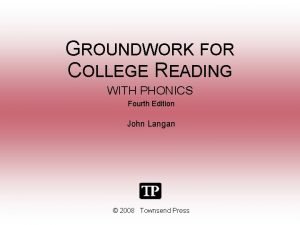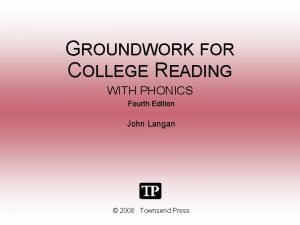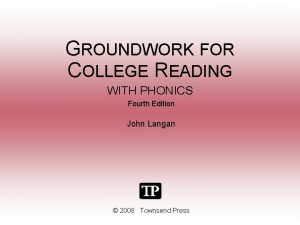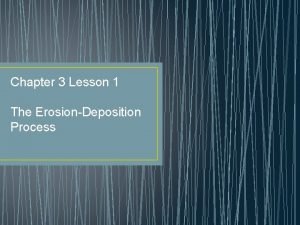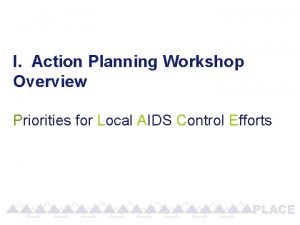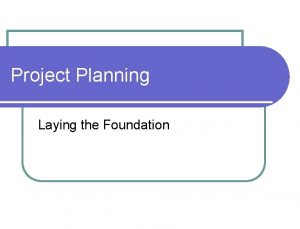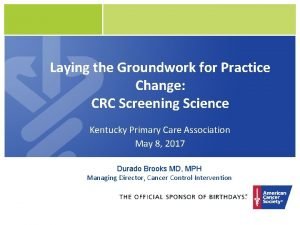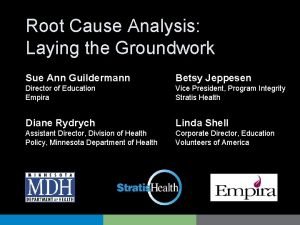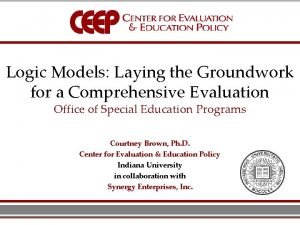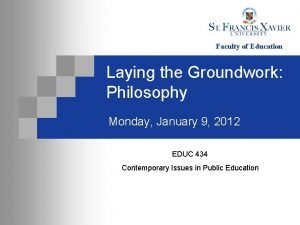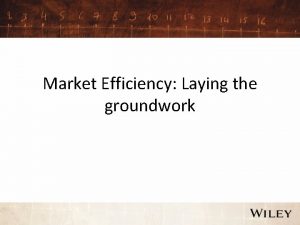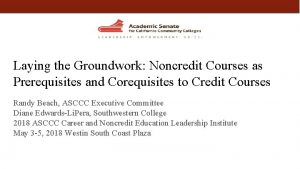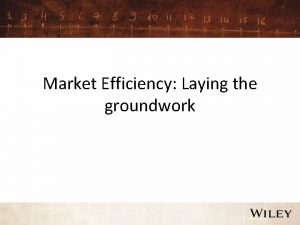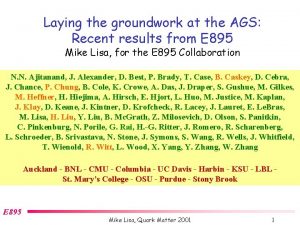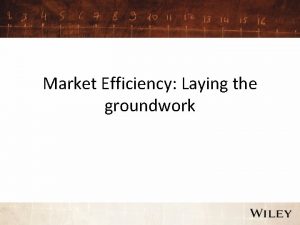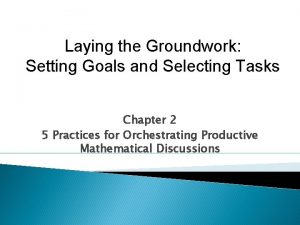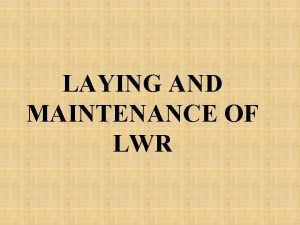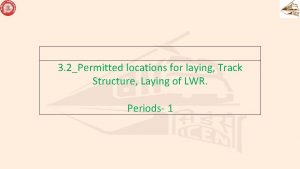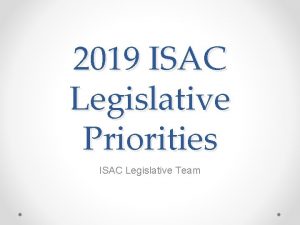Legislative Planning Workshop Laying the Groundwork for the





































- Slides: 37

Legislative Planning Workshop Laying the Groundwork for the 87 th Session of the Texas Legislature

State Revenue Outlook & Economic Impact of 2020

Total General Operations Funding (All Districts) Federal Funds 2% State Operating Funds 46% Other Local 2% Local Property Tax from M&O 50% Source: PEIMS 2019 - 2020 Budgeted Financial Data State Total (All Districts), modified to include recapture as local property tax

General Appropriations Act 2020 -21 Biennium ALL FUNDS GENERAL REVENUE • $248. 3 billion total • $64. 6 billion for TEA, which is 26% of the total • $118. 3 billion total • $44. 7 billion for TEA, which is 38% of the total

General Revenue Expenditures (2020 & 2021) Public Safety & Criminal Justice 10% TRS, SBVI, TSD, Higher Education 18% Other: The Judiciary - 0. 5% Natural Resources - 0. 9% Business & Economic Development - 0. 4% Regulatory - 0. 3% The Legislature - 0. 3% Other 2% General Government 3% Health and Human Services 28% [CATEGORY NAME] [PERCENTAGE] Source: General Appropriations Act for the 2020 – 21 Biennium (Final, December 2019)

General Revenue-Related Revenues Source: Texas Comptroller of Public Accounts, Certification Revenue Estimate, October 2019

State Sales Tax Revenue – 2019 vs. 2020 3 500 000 13. 2% less than May 2019; steepest yearover-year decline since January 2010 3 000 2 500 000 2 000 1 500 000 1 000 500 000 Sales Taxes 2019 Sales Taxes 2020 Au gu st ly Ju ne Ju ay M il Ap r ch ar M br ua ry y Fe nu Ja be m ce ar r r be De m ve ob ct O No Se pt e m be r er 0 Source: TX Comptroller of Public Accounts

The Price of Oil West Texas Intermediate (WTI) Crude – June 2019 -June 2020 • Price of oil assumed to be $58/barrel in 2020 and $54/barrel in 2021 in state revenue estimates. So far, it has rebounded from negative numbers to $38. • The Severance Tax experienced a 75. 6% drop when comparing May 2019 to May 2020.

Differences from projections and reality 10, 00% 5, 00% 0, 00% -5, 00% Sales Tax Motor Vehicles Tax 3, 40% 1, 21% Natural Gas Tax Oil Alcoholic Cigarette Production Beverage Tax and Tax Tobacco 4, 00% 1, 00% 0, 00% -3, 46% -4, 00% -4, 59% Motor Fuels Taxes 1, 60% -3, 36% -10, 00% -12, 00% -15, 00% -20, 00% -25, 00% -30, 00% -35, 00% -33, 58% -13, 34% -13, 10% What was once projected to be a $2. 9 billion surplus is now $1. 8 billion behind projections; if trends do not improve, could be $6 billion behind before end of FY 2020. -40, 00% Projected Growth 2020 YTD Growth Source: Comptroller of Public Accounts

Unemployment & other increased needs

Impact on property values & collections • Property values for Tax Year 2020 will be based on the value of property on January 1, 2020. • That doesn’t mean taxpayers will have the ability to pay taxes according to the January value. • Unknown impact on property values for 2021 at this time, but likely to take a hit, especially in certain areas.

Economic Stabilization Fund (in billions) Balance, Deposits, & Expenditures 2006 -07 Biennia through 2020 -21 (est. ) $12, 0 $10, 3 $10, 0 $8, 0 $6, 7 $6, 0 $5, 5 $4, 0 $2, 5 $0, 0 -$2, 0 -$4, 0 -$6, 0 -$8, 0 -$1, 2 $8, 5 $5, 0 $1, 5 $6, 8 $6, 2 $4, 3 $3, 0 $1, 8 $2, 5 -$0, 0 -$0, 1 -$3, 2 -$1, 9 $3, 5 -$1, 2 -$2, 0 -$6, 0 2006 -07 2008 -09 2010 -11 2012 -13 2014 -15 2016 -17 2018 -19 2020 -21 Economic Stabilization Fund Ending Balance Fund Deposits Fund Expenditures

Questions over sustainability of HB 3 • $6. 4 billion increase invested into public schools over the biennium • $5. 2 billion cost for property tax rate compression for the biennium, with a cost that will grow

Historic Overview of Funding Cuts

2001 Recession • September 11, 2001 exacerbated an economic slowdown • Comptroller projected $7. 3 billion reduction (biennium to biennium) or $9. 9 billion compared to current services

2003 Budget Decisions • Shortfall within the biennium caused a $1. 8 billion shortfall within the 2003 fiscal year • State asked for 7% agency reductions • Appropriated $450 million from the Economic Stabilization Fund • 2004 – 2005 Biennial Budget Reductions • GR appropriations reduced by $2. 6 billion compared to prior biennium • $811 million used from Economic Stabilization Fund • Revenue mechanisms increased GR by $1. 8 billion • $1. 3 billion federal funds increase

Public Education in the 2003 Legislative Session • FSP fully-funded and $110 per WADA provided to ISDs • FSP payment delay “saves” $800 million • Other Education programs reduced • Textbooks were appropriated $219 million less than projected cost ($121 million less than 2002 -2003 biennium) • Student Success Initiative reduced by $65 million • DAEP reduced by $26 million • High School Program reduced by $25 million • Reading / Math initiative reduced by $15 million • Agency FTE cap reduced from 860 to 766

The Great Recession • In 2007 -2008, the subprime mortgage crisis caused “The Great Recession” which had economic ramifications over several years • In 2009, the US Congress passed the American Recovery and Reinvestment Act (ARRA), and the State used those ARRA dollars to back-fill holes in the budget for the 2010 -2011 biennium, thereby avoiding funding cuts for schools • In 2011, with no federal money remaining, the State of Texas was left with the holes created by both legislative action and the economic collapse

Circumstances that caused 2011 cuts 2009 -2013 • Major property tax compression from HB 1 in 2006

HB 1 – 79 th Legislature, 3 rd Called Session 2006

Circumstances that caused 2011 cuts 2009 -2013 • Major property tax compression from HB 1 in 2006 • National & State economic recession (“The Great Recession”).

Circumstances that caused 2011 cuts 2009 -2013 • Major property tax compression from HB 1 in 2006 • National & State economic recession (“The Great Recession”). • Federal stimulus used to supplant, not supplement (ARRA)

© 2 0 1 9 1 / 2 0 T 2 e 2 x a s A s s o c i a t i o n o f S c h o o l B u s i n e s s O f f i c i a l s. A l Federal Stimulus “Of the ARRA funding spent in the 2010– 11 biennium, $3. 3 billion was used as a method of financing for the Foundation School Program and $361. 6 million was used for instructional materials, expenditures that would have otherwise required additional outlay of General Revenue Funds in order to fund them at the same level. The remaining $467. 0 million in federal ARRA funding comprised supplemental grants delivered to school districts primarily through Title I of the federal No Child Left Behind Act, 2001, (funds directed for services to economically disadvantaged students) and the federal Individuals with Disabilities Education Act (funds directed for special education services). ”

Circumstances that caused 2011 cuts 2009 -2013 • Major property tax compression from HB 1 in 2006 • National & State economic recession (“The Great Recession”). • Federal stimulus used to supplant, not supplement (ARRA) • State budget shortfall

© 2 0 1 / 2 0 T 2 e 2 x a s A s s o c i a t i o n o f S c h o o l B u s i n e s s O f f i c i a l s. A l

Circumstances that caused 2011 cuts 2009 -2013 • Major property tax compression from HB 1 in 2006 • National & State economic recession (“The Great Recession”). • Federal stimulus used to supplant, not supplement (ARRA) • State budget shortfall • Request for 5% state agency budget reductions

2011 Program Cuts included in TEA’s 5% Reduction © 2020 Texas Association of School Business Officials. All rights reserved. Do not duplicate or distribute without express permission. 1/1/2022 27

Present circumstances are eerily familiar… 2009 -2013 2020 -? ? ? • Major property tax compression from HB 1 in 2006 ü Major property tax compression from HB 3 in 2019 • National & State economic recession (“The Great Recession”). • Federal stimulus used to supplant, not supplement (ARRA) ü National & State economic recession (caused by virus, market crash, economic shut-down, etc. ) • State budget shortfall • Request for 5% state agency budget reductions ü Federal stimulus used to supplant, not supplement (CARES Act) ü Potential state budget shortfall ü Request for 5% State Agency budget reductions

2011 Budget Decisions • • Additional 2. 5% State Agency Budget Reductions Appropriations from Rainy Day Fund Revenue & Accounting Measures Significant Funding Cuts ($5. 4 billion cut from Public Education)

2011 Public Education Budget Decisions • State faced projected $27 billion shortfall and initially proposed $10 billion cut to education. • Cut $5. 3 billion from public education ($4 billion from formula, $1. 3 billion in programs). v Regular Program Allotment (FY 2012) Adjustment Factor 92. 39% $2. 0 Billion v Regular Program Allotment (FY 2013) Adjustment Factor 98% $0. 5 Billion v Target Revenue/ASATR Reduction (FY 2013) Adjustment Factor 92. 35% $1. 5 Billion In addition to the amounts above, no appropriation was made for the FSP New Instructional Facilities Allotment (NIFA), a decrease of $50 million from the prior biennium.

© 2 0 1 / 2 0 T 2 e 2 x a s A s s o c i a t i o n o f S c h o o l B u s i n e s s O f f i c i a l s. A l 2012 -2013 Biennium $1. 3 Billion in non-FSP Public Education Cuts • • • Pre-K Grant & Readiness Programs $209. 2 million District Awards for Teacher Excellence (DATE) Program $332. 5 million Student Success Initiative $237. 1 million Technology Allotment $270. 9 million High School Completion Initiatives $59. 2 million Advanced Placement Initiative $11. 9 million Communities in Schools $12. 1 million Optional Extended Year Program $14. 1 million Regional Service Centers $17. 8 million TDCJ (Windham) Schools $33. 1 million Early High School Grad Scholarship $43. 2 million Other Programs & TEA Administration $58. 5 million

1 / 2 0 2 2 32

What is possible as we look ahead?

A word about proration • FSP funding for the 2019 -2020 school year will not be prorated. • However, there are mechanisms in statute to allow state leadership to reduce expenditures by state agencies (likely including the FSP if necessary) when needed to deal with an emergency, including a reduction in state revenue. • We have NOT heard that the State is considering such a move at this time, but we do not know how bad things will get or how long this will go on, so anything could be possible if deemed necessary.

Everything is on the table. Basic Allotment of $6, 160

Formula Transition Grant • The new hold harmless/ASATR • Guarantees that a district receives at least 3% more in 2019 -2020 under the new law than they would have been entitled to under the previous law on a per-student basis (within certain limits) • New dollars for the district (outcomes funding, other incentives, increased tax rate, etc. ) don’t result in additional funding, just less transition grant. • Expires after 2023 -24 school year (but maybe sooner…)

Options for School Finance • Payment delay (push August 2021 payment to September 2021, and push the August 2023 payment as well…) • Cut programmatic funding • Formula cuts – reduce Basic Allotment or other formula factors (TEMPORARILY), cut or eliminate Transition Grants • Find savings by eliminating mandates/requirements
 Nonlegislative powers of congress
Nonlegislative powers of congress Major and minor supporting details
Major and minor supporting details Main idea
Main idea Groundwork for college reading
Groundwork for college reading Rwd html
Rwd html Laying on table
Laying on table Put aside every weight
Put aside every weight Animal riddles who am i
Animal riddles who am i Characteristics of quality culture
Characteristics of quality culture Canyouunit
Canyouunit Laying the tablecloth
Laying the tablecloth Egg laying animals
Egg laying animals Summation formulas
Summation formulas Laying aside all malice
Laying aside all malice The laying down or settling of eroded material
The laying down or settling of eroded material Action planning workshop
Action planning workshop Strategic planning workshop greater manchester
Strategic planning workshop greater manchester Strategic planning workshop exercises
Strategic planning workshop exercises Action planning workshop
Action planning workshop Atmosfr
Atmosfr Rutin för avvikelsehantering
Rutin för avvikelsehantering Meios steg för steg
Meios steg för steg Myndigheten för delaktighet
Myndigheten för delaktighet Presentera för publik crossboss
Presentera för publik crossboss Kung som dog 1611
Kung som dog 1611 Förklara densitet för barn
Förklara densitet för barn Debattartikel struktur
Debattartikel struktur Tobinskatten för och nackdelar
Tobinskatten för och nackdelar Tack för att ni lyssnade bild
Tack för att ni lyssnade bild Tack för att ni har lyssnat
Tack för att ni har lyssnat Referatmarkeringar
Referatmarkeringar Fimbrietratt
Fimbrietratt Verifikationsplan
Verifikationsplan Karttecken brant
Karttecken brant Fuktmätningar i betong enlig rbk
Fuktmätningar i betong enlig rbk Vätsketryck formel
Vätsketryck formel Större och mindre tecken
Större och mindre tecken Elektronik för barn
Elektronik för barn

